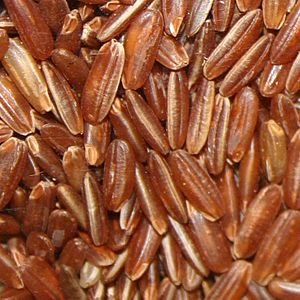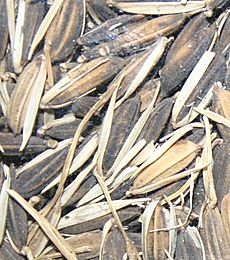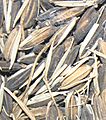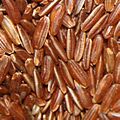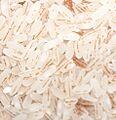Brown rice facts for kids
Brown rice is a type of rice that is considered a whole grain. This means it still has its outer layers, like the bran and germ, which are usually removed to make white rice. Think of it like a whole apple with its skin on, compared to a peeled apple! Other whole rices include red rice, gold rice, and black rice (sometimes called purple rice), which have different colored outer layers.
Contents
Cooking Brown Rice
Brown rice usually takes a bit longer to cook than white rice. This is because of its outer layers. It can take anywhere from 35 to 50 minutes to cook a batch of brown rice.
Parboiled Rice
There's a special way to prepare rice called "parboiling." This process helps push some of the healthy vitamins from the outer hull into the rice kernel before the hull is removed. This makes the rice more nutritious than regular white rice and can also help it cook a little faster.
Storing Brown Rice
Brown rice can stay fresh for about 6 months. But if you keep it in a cool place like a fridge or freezer, it can last much longer! Freezing it, even for short times, can also help keep away tiny bugs called Indian meal moths.
Arsenic in Rice
Rice plants can naturally take in a substance called arsenic from the soil and water. Because brown rice keeps its outer layers (the bran), it tends to have more arsenic than white rice.
Some countries, like those in the European Union, have rules about how much arsenic can be in rice. The amount of arsenic in rice can change depending on where it's grown. This is because natural arsenic levels in the ground vary. Also, arsenic from certain pesticides or fertilizers can be absorbed by rice plants.
A report in 2012 found arsenic in almost all types of rice and rice products tested in the US. This report also said that brown rice generally has about 80% more inorganic arsenic than white rice of the same kind. This is because arsenic collects in the outer parts of the grain. Another study found that people who ate rice had higher levels of arsenic in their bodies.
What's Inside Brown Rice?
Brown rice and white rice have similar amounts of calories and carbohydrates. However, brown rice is a whole grain and is packed with good stuff! It's a great source of:
- Magnesium
- Phosphorus
- Selenium
- Thiamine (Vitamin B1)
- Niacin (Vitamin B3)
- Vitamin B6
- Manganese
- Fiber
White rice has its bran and germ removed, so it has different nutrients. When these layers are taken off, some important vitamins and dietary minerals are lost. These include healthy oils, dietary fiber, and magnesium. Sometimes, vitamins like B1, B3, and iron are added back into white rice. In the US, this is called "enriched rice."
Germinated Brown Rice
Have you ever heard of Germinated brown rice (GBR)? It's brown rice that has been soaked in warm water for several hours before cooking. This soaking makes the rice start to sprout, or "germinate." This process activates different helpful things in the rice, making it even more nutritious. GBR is also softer when cooked, which many people, especially children, prefer over regular chewy brown rice.
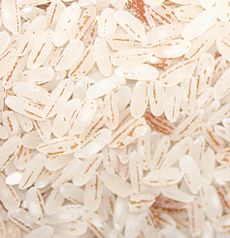
The same rice, with almost all bran and germ removed to make white rice
|
Images for kids
-
The same rice, with almost all bran and germ removed to make white rice
See also
 In Spanish: Arroz integral para niños
In Spanish: Arroz integral para niños


